In the year 1944, the allies were already clear that they were going to win the Second World War. His troops advanced through Italy, the Soviets pushed the Germans west, and the Normandy landings were successfully carried out that summer. That is why it is not surprising that work was already being done on how to manage the occupation of Germany and one of the proposals came from the US Treasury Secretary, who advocated the destruction of most of German industry to ensure that it would not rearm. It was the so-called Morgenthau Plan, which was finally only applied for two years due to the context of the Cold War.
Henry Morgenthau Jr. was born in New York in 1891, into a wealthy family. He studied architecture and agricultural engineering; The latter helped him, when he finished his degree, not only to open a business growing fir trees for Christmas, but also to focus his professional life on agriculture, advocating its modernization from the magazine American Agriculturalist, which he directed from 1922.
In those years he met Franklin Delano Roosevelt, who appointed him chairman of the New York State Agricultural Advisory Committee and the State Conservation Commission when he was elected governor.
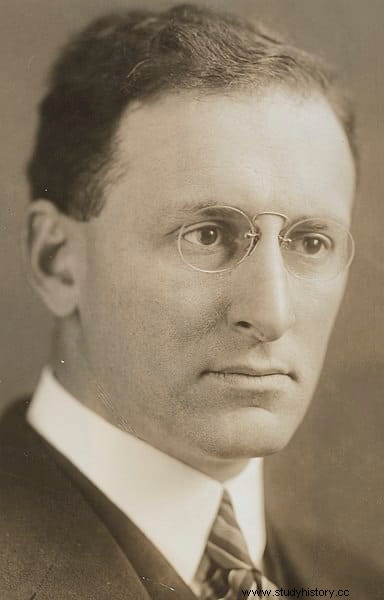
His relationship with Roosevelt continued and when he became president of the United States in 1933 he chose his friend to be in charge of the Secretary of the Treasury, given that the main and successful measure to stop price deflation -by raising the price of gold- it had been his idea.
Something curious because Morgenthau was opposed to the Keynesian doctrine and, therefore, also declared himself in favor of private investment and suspicious of the New Deal , the interventionist policy imposed by Roosevelt to fight against the Great Depression. His management as secretary focused on the fight against corruption -supported by the FBI- and the reduction of the national debt.
But Morgenthau did not forget his origins, so, in addition to all these actions of his position, he also promoted others of a different nature:those aimed at helping European Jews, victims of Nazi persecution. World War II was already advanced when Germany decreed the Final Solution and the world began to be aware of the situation.
In 1943, the Secretary of the Treasury promoted the celebration of the WJC (World Judish Congress , World Jewish Congress), with the aim of rescuing Jews using accounts in Switzerland. A few months later he created the WRB ( War Refugee Board , Board of War Refugees) and facilitated the procedures for the immigration of fugitive Jews, thanks to which some two hundred thousand arrived in the US.
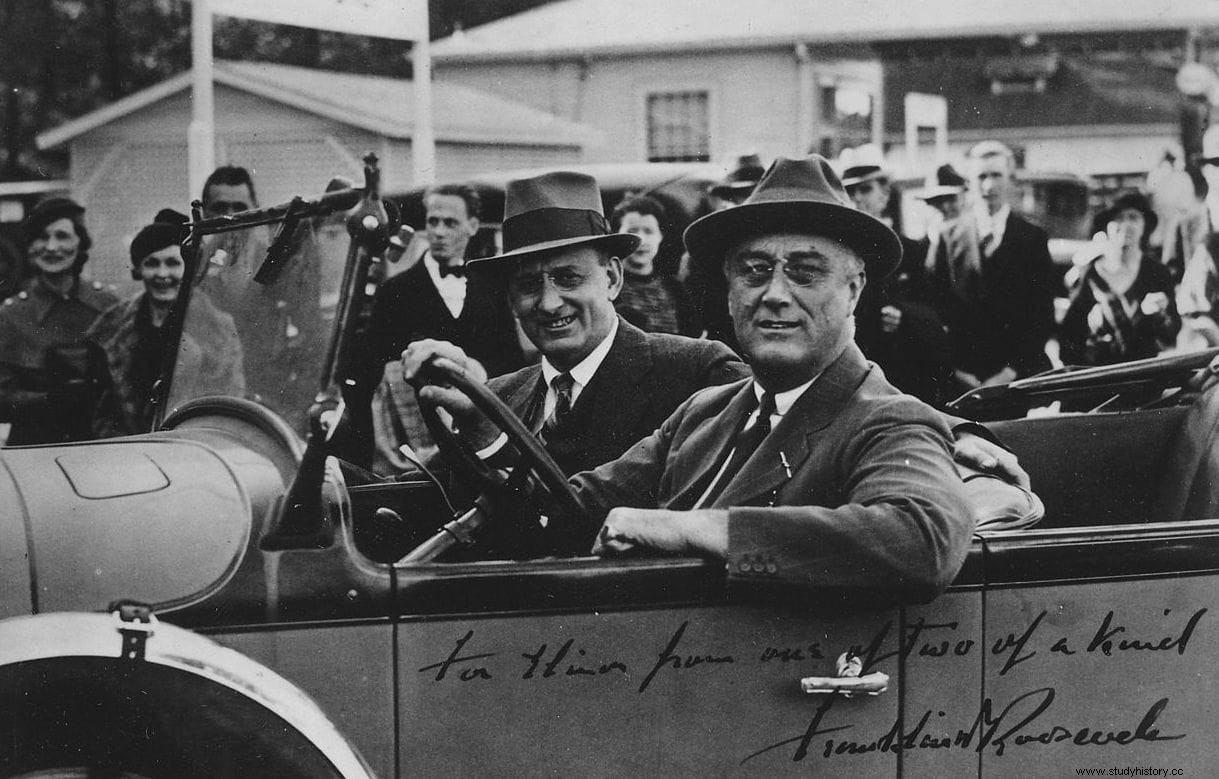
Likewise, it was Morgenthau who, in the summer of 1944, proposed the trial and execution of a hundred of the most prominent Nazi criminals who were captured. But the guilt of the Hitler regime extended, in reality, to the entire Teutonic nation. At an unspecified date in the same year he wrote a memorandum entitled Suggested Post-Surrender Program for Germany , which he presented to the president and, in fact, the original is still preserved in the Franklin D. Roosevelt Presidential Library and Museum . It would be the text of what would become known as the Morgenthau Plan.
For the writing he had the help of Harry Dexter White, his right hand in the ministry and liaison with the State Department. He was a descendant of Lithuanian Jews who emigrated in the 19th century who had specialized in international financial affairs, being in favor of maintaining peace through trade and defending the creation of global organizations to monitor said peace. This was the case of the International Monetary Fund or the World Bank, of whose foundation he is considered one of the main architects; Not surprisingly, he was the American representative at Bretton Woods, where the United Nations Monetary and Financial Conference was held in July 1944.
White was also in favor of keeping the Soviet Union as an ally, making it clear that he was an admirer of theirs. Something that in 1948 was going to have a special importance because that year White became the protagonist of a notorious scandal when he was formally accused of spying for the Soviets. It was never shown that he was a member of the Communist Party, but under the pseudonym jurist he had passed information to the NKVD, as some double agents had already warned three years before, which is why he was being watched in what was dubbed Project Venona. A heart attack killed White two days after giving evidence, so he escaped trial.
Now in 1944 he was still Morgenthau's collaborator and, as co-author of the memorandum, a staunch anti-Nazi. The text presented to Roosevelt had various points whose application would clear Germany of any hint of a possible military rebirth. Because, first of all, he proposed their complete demilitarization and in the shortest time possible, once they signed their surrender. This implied the destruction of its entire arsenal and armament factories, including the auxiliary ones. The Ruhr basin and the surrounding regions (the Rhineland and the entire territory north of the Kiehl Canal) would be the most affected areas, since the industrial fabric was concentrated there.

Specifically, its total dismantling was advocated within a maximum period of six months, seizing the machinery as compensation and demolishing what remained after that time had elapsed. That meant encouraging the inhabitants to emigrate to other places, leaving the place as an international zone under the control of some United Nations agency. There would be no compensation, since the Germans were responsible for the war and the measure was part of a war reparations plan that could include the confiscation of German assets outside the country, the provision of forced labor or even the sterilization of people.
On the other hand, the Mongerthau Plan provided for the partition of Germany, so that, as we have seen, the Ruhr and the Kiehl Canal would be alienated, while Upper Silesia and two thirds of East Prussia would be given to Poland (the other third would be for the Soviet Union). On the western frontier, Denmark would annex southern Jutland, while France would annex the Saar and the adjoining territories bounded by the Rhine and Moselle rivers. As for the rest of the country, it would be divided into two autonomous and independent halves:a southern one, made up of Bavaria, Württemberg, Baden and several smaller states; and another northern one made up of Saxony, Thuringia and the areas of Prussia that the Poles and Soviets had not shared, and which would have a customs union with Austria, according to the borders prior to 1938.
The drastic measures planned by Morgenthau were intended to prevent a German reconstruction, thus opposing what the Secretary of State, Cordel Hull, planned:to improve the economy of the Germans through collaboration with US businessmen so that, in a reasonable period of time, they could start paying war reparations. Instead, the Treasury Secretary was of the opinion that the Germans should only "be fed three times a day with soup from the Army soup kitchens and they would remember that experience for the rest of their lives» or else they would go back to their old ways and spark a new feud in a decade.
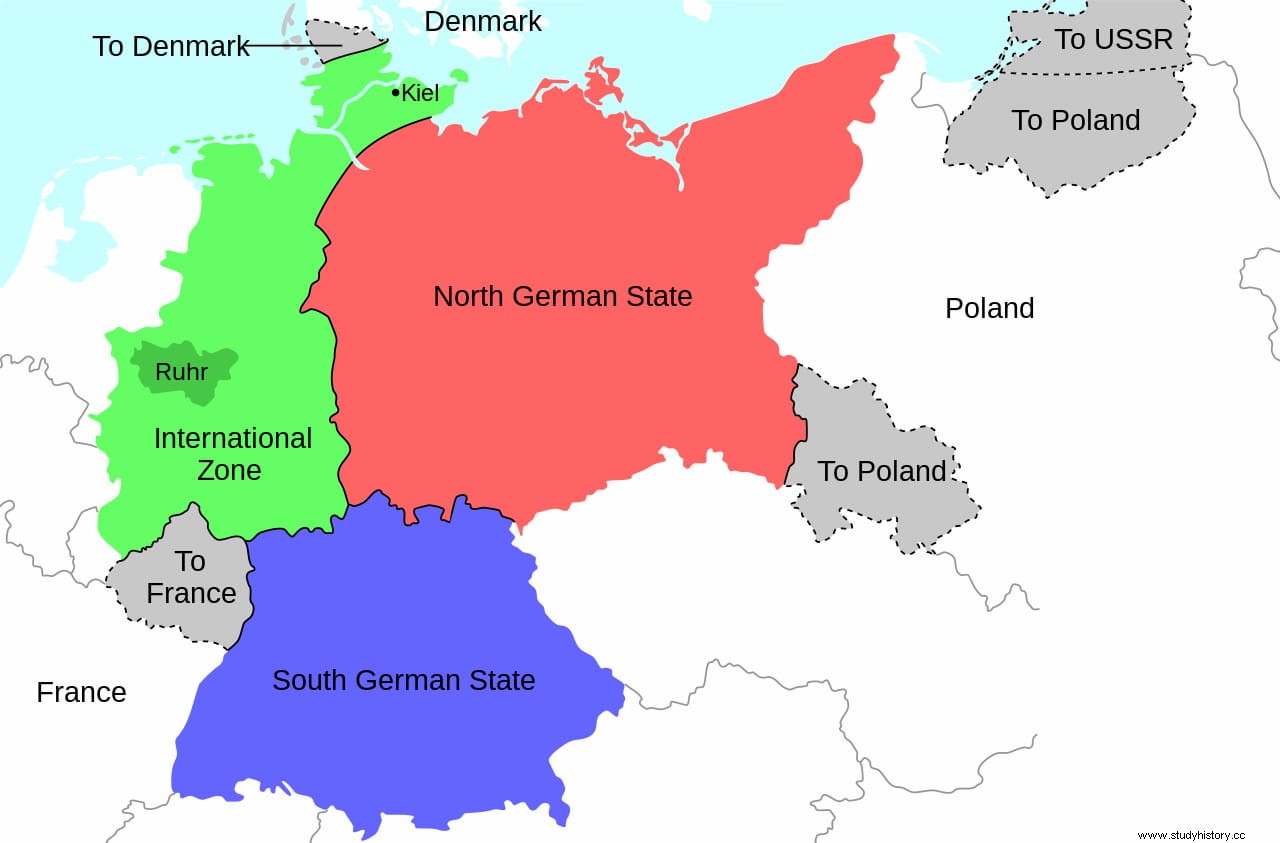
Roosevelt then created a committee that included Morgenthau, Hull, and Henry L. Stimson, Secretary of War. They had to work together, although in practice each one had their own and inalienable vision and not only were they unable to collaborate but they came to confrontation and each one wrote their own memorandum. Morgenthau was lucky because, possibly because of the stress, Hull fell ill and the President, who was to bring Hull as adviser to the Second Quebec Conference (September 1944), appointed the Secretary of the Treasury to replace him.
It is possible that this designation was also influenced by the fact that Roosevelt wanted to build bridges with Stalin - let us remember that Morgenthau admired the Soviet leader -, although he himself was in favor of a strong hand, «let the Germans know that this time at least they have definitely lost the war» . But in Canada he found that Churchill did not like the plan, or at least not in its entirety; "England would be chained to a corpse" he said as he was reluctant to sign it. It was necessary to negotiate, something that the subordinates took care of:Morgenthau and White on the North American side, Frederick Lindemann (scientific advisor to the premier ) by the British. Lindemann detested Nazism and was eager for revenge, so the way seemed paved. However Churchill continued to refuse; he agreed with the deindustrialization of Germany, but not with its partition.
In the end, the decision had to be “bought”:in exchange for the US granting credits totaling six and a half billion dollars, Great Britain would accept the text; duly reformed, yes, eliminating that second part in favor of what was to be known as the Oder-Neisse Line (delivery to Poland of the eastern German territories, as a border on the two homonymous rivers) thanks to Soviet intermediation. Not everyone agreed; Anthony Eden, a member of the British delegation, openly declared himself against it and Hull warned that the application of the Morgenthau Plan would condemn the Germans to live exclusively in the countryside, which would mean the death of forty percent by starvation.
Stimson even had a confrontation with Roosevelt when the latter denied that he wanted total deindustrialization and the other accused him of wanting to deceive him, showing him his signature on the document. According to later analysts, the president was not fully aware of what the Morgenthau Plan entailed. Things got worse in September, when someone in the Treasury department with access to the memo leaked it to the press (White himself provided an advance copy to Soviet intelligence) and journalist Drew Pearson published it. Pearson did it because he agreed with his controversial points and sought the support of the American public, but the move backfired. 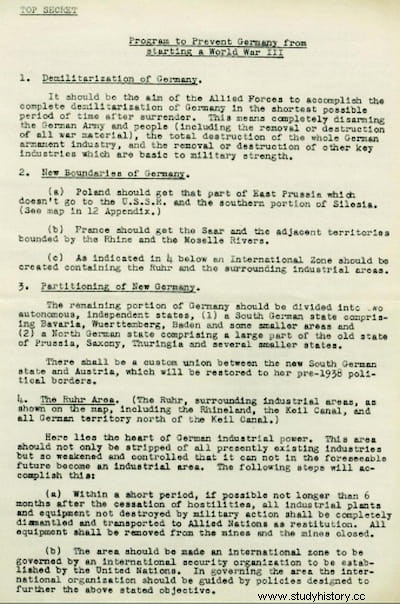
Newspapers like The Wall Street Journal or The New York Times they were very critical, warning that this project would make Germany not surrender but would resist until the end, knowing that the alternative was destruction and death. Indeed, Goebbels jumped at the chance and denounced that the Jewish Morgenthau was seeking the extermination of the Germans with the help of Roosevelt and Churchill, turning the nation into "a potato field" . Even the US military spoke out against it. Generals George Marshall and Omar Bradley, plus Lieutenant Colonel John Boettiger, the president's son-in-law, complained that the enemy had redoubled their efforts and the plan had cost them thirty divisions at Aachen.
Protests and objections forced Roosevelt to take a partial step back, personally distancing himself as if he had had nothing to do with it. The information that arrived from the intelligence services at the front was not encouraging, because even the press echoed the German will to save not the regime but the homeland, regardless of whether he left the Nazis or the opposition. A few months later, his last weeks embittered by that controversy, the president died and was succeeded by the vice president, Harry S. Truman, under whose mandate World War II ended with the German surrender.
It was he who ordered the JCS 1067 directive for the military occupation of Germany in the area assigned to the US, largely following the provisions of the Morgenthau Plan. A maximum production in the iron and steel industry of twenty-five percent with respect to the pre-war period was decreed, proceeding to dismantle facilities so as not to exceed that percentage. The rest of the industry would remain at fifty percent, taking 1938 as a reference, which meant the suppression of a thousand and a half factories. As agreed at the Potsdam Conference, Germans would not be allowed to have a higher standard of living than other Europeans, despite the fact that experts insisted that this condemned twenty-five million of them to starvation.
The problem turned out to be bigger. Germany was the locomotive of the continent and condemning it to poverty dragged the other countries, weighing down the recovery of all. In addition, it forced the occupying powers to make a huge outlay to alleviate these effects through GARIOA (Governement Aid and Relief in Occupied Areas , Government and Relief in Occupied Areas). But the worst thing was that the painful situation, in that context of the nascent Cold War, posed the danger that the Germans would lean towards communism. That is why after two years of harsh politics, it was decided to change.
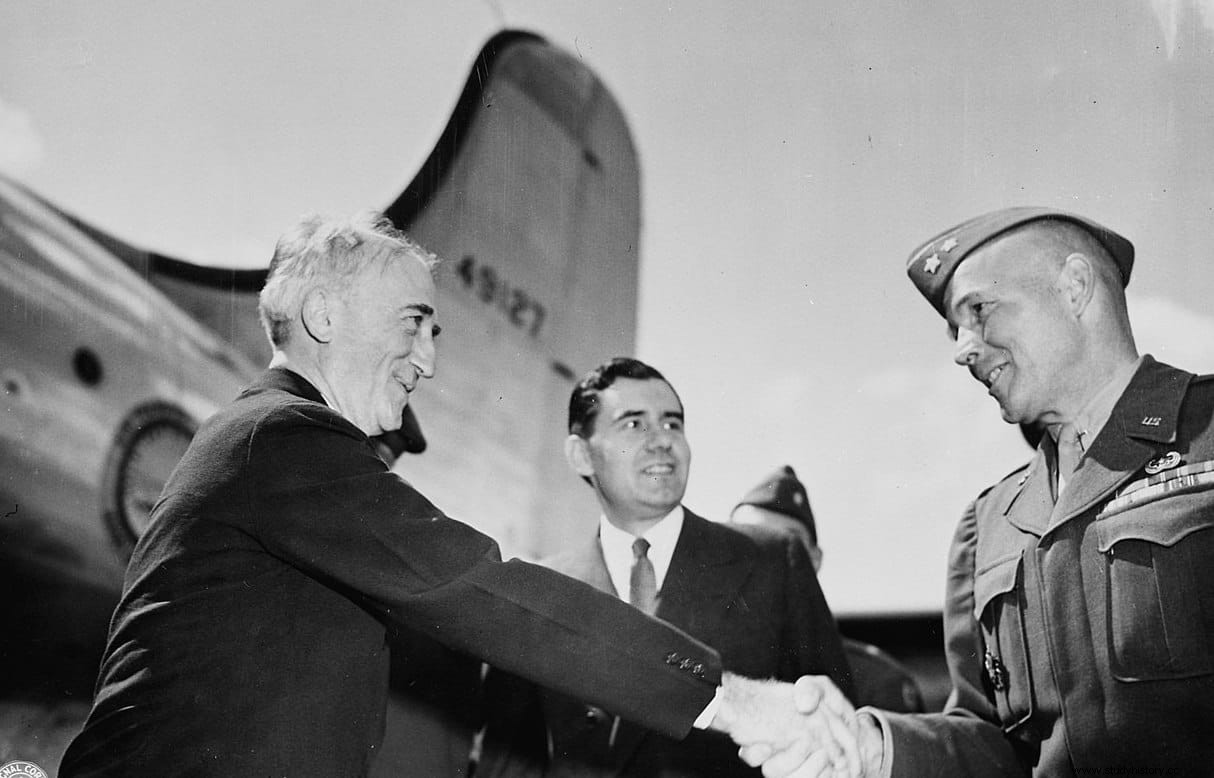
It was announced by the new Secretary of State, James F. Byrnes, during a speech in Stuttgart in September 1946. It was titled Restatement of policy on Germany (Rethinking the policy on Germany), although it was popularly known as the "Speech of Hope", since it put an end to the Morgenthau Plan and opened the door to an era of cooperation and reconstruction that was to be reflected in the famous Marshall plan. Truman replaced JCS 1067 with JCS 1779, and although before he left, US Treasury officials in Germany (nicknamed the Morgenthau children ) made sure to bring down the Teutonic banking system, the currency reform of 1948 started what was to be the Wirtschaftswunder the economic miracle.
It wasn't easy, of course. Many industrial facilities had been moved to other countries (mainly France and the USSR) and, as feared, the number of Germans who died of starvation or associated diseases turned out to be quite high. Likewise, more than four million prisoners of war were forced to perform forced labor in the Allied countries, giving them the status of Disarmed enemy forces (Unarmed Enemy Forces) to circumvent the Geneva Convention. In 1953 it was established that Germany should repay the economic aid provided, valued at one thousand one hundred million dollars; he finished paying for it in 1971.
And Henry Morgenthau? In the fall of 1945 he had published the book Germany is our problem (Germany is our problem), in which he explained the details of his plan and of which General Eisenhower (military governor of the US-occupied zone) had distributed a thousand volumes among his officers, as a guide to action, supporting him implicitly. Morgenthau resigned when Truman assumed the presidency, with Colonel Bernard Bernstein in charge of defending the plan for those two years. He went on to work for Jewish philanthropies and even served as a financial advisor to Israel, where he named a community farm after himself. He passed away in Poughkeepsie (New York State) in 1967.
